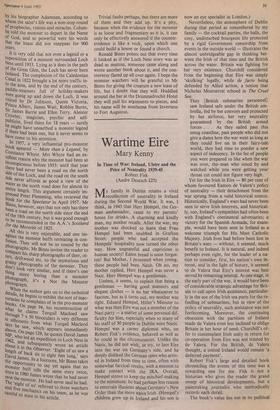Not the Monster
Artemis Cooper
The Loch Ness Mystery Solved Ronald Binns (Open Books Publishing Ltd £7.95)
The monster is very big and easilY recognisable, having a small head on a long neck, rough skin of an indeterminate colour, and flippers. It does not seem to be in Loch Ness so it could be anywhere, strug- gling miserably with a large-scale maP 01 the Highlands. If you see the beast please take the trouble to give it some direction.s, and alert the Ness and Morar Survey of.its impending arrival. They have been looking for the monster for a very long time. Evidence for the existence of a large unidentified creature in Loch Ness is based on photographs, film footage, sonar readings, and innumerable sightings byall sorts of respectable people including surgeons and retired colonels. In The Loch Ness Mystery Solved, Ronald Binns says the evidence is too thin and insubstantial to be convincing. The book will never convert the confirmed monster buff, but it makes satis- fying reading for the sceptic. The author starts by looking into the story's rather shaky beginnings in the Inverness Courier in 1933, and then enquires into what there was in the way of a monster tradition at Loch Ness before that. The monster was first seen by Saint Columba. He might have made a reliable witness, but unfortunately the incident was written uP
by his biographer Adamnan, according to whom the saint's life was a non-stop round of prophecies, visions and miracles. Colum- ba told the monster to depart in the Name of God, and so powerful were his words that the beast did not reappear for 900 Years.
It is very odd that not even a legend or a superstition of a monster surrounded Loch Ness until 1933. Lying as it does in the path of the Great Glen, the Loch has never been isolated. The completion of the Caledonian Canal in 1822 brought a lot more traffic in- to the area, and by the end of the century, Paddle-steamers full of holiday-makers were going up and down the Loch. It was visited by Dr Johnson, Queen Victoria, Prince Albert, James Watt, Robbie Burns, Sir James Barrie and Ellen Terry. Aleister Crowley, magician, psychic and self- Publicist, lived there for 18 years — surely he might have unearthed a monster legend if there had been one, but it never seems to have come to his attention.
In 1957, a very influential pro-monster book speared — More than a Legend, by Constance Whyte. Mrs Whyte had an ex- cellent reason why the monster had been so inconspicuous before 1933: until that year there had never been a road on the north side of the Loch, and the road on the south side never affords as good a view of the water as the north road does for almost its entire length. This argument certainly im- pressed Peter Flemming, who reviewed the book for the Spectator in April 1957. Mr Binns, however, says that not only has there been a road on the north side since the end of the 18th century, but it was good enough to be recommended in the A.A.'s Scotland for the Motorist of 1925. All this is very enjoyable, and one im- agines the monster buffs retreating in con- fusion. They will not be so routed by the Photographs. Mr Binns invites the reader to Compare his sharp photographs of deer, ot- ters, driftwood etc. to the mysterious and grainy photographs of the monster. They don't look very similar, and if there's one thing more boring than a monster
Photograph, it's a Not the Monster Photograph,
When the author gets on to the technical details, he begins to exhibit the sort of inac- curacies he complains of in the pro-monster books. On page 94, his reconstruction of what he claims Torquil Macloed saw through 7 x 50 binoculars is very different In silhouette from what Torquil Macleod says he saw, which appears immediately _above. On page 129, he quotes David James M. PI, who led an expedition to Loch Ness in 1962, and subsequently wrote an article al bout it in the Observer. 'Eight of us saw a
David James. In a footnote, Mr Binns takes the opportunity to say yet again that no monster buff tells the same story twice, since in 1980 James wrote that he had never seen the monster. He had never said he had. The 'eight of us' referred to three watchers and five mechanics on his team, as he was careful to state in his article. Trivial faults perhaps, but there are more of them and they add up. It's a pity, because when the evidence for the monster is as loose and fragmentary as it is, it can only be effectively answered if the counter- evidence is like a rock, upon which one could build a house or found a church.
Ronald Binns points out that every time it looked as if the Loch Ness story was as dead as mutton, someone came along and wrote another book about it, and the con- troversy flared up all over again. I hope the monster watchers will be grateful to Mr Binns for giving the creature a new lease of life, but I doubt that they will. Huddled around the bar at the Drumnadrochit Hotel they will pull his arguments to pieces, and his name will be anathema from Inverness to Fort Augustus.















































 Previous page
Previous page